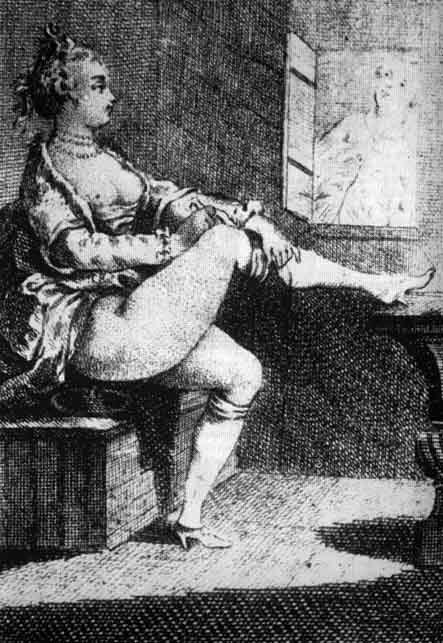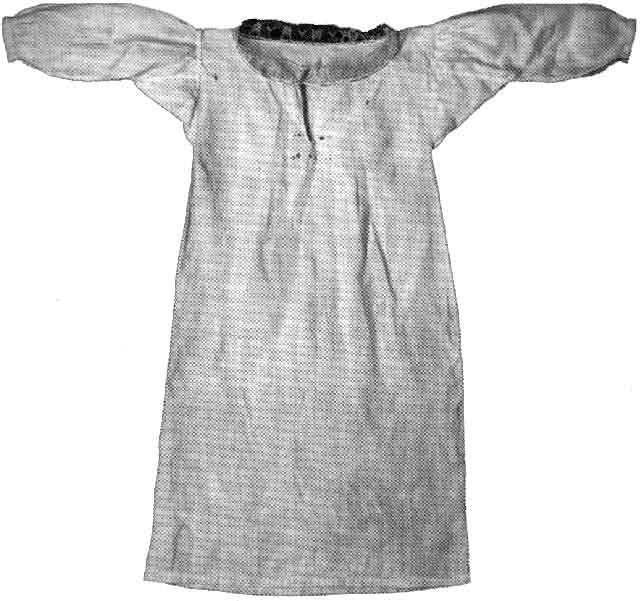Read an earlier discussion of this: What did
European and American women use
for menstruation in the 19th century and before?


|

Some facts about European underwear, 1700 - 1900,
and its
relationship to what women used for menstruation
(Part 2, Part 3)
In brief - how's
that for a pun! - here's what I think:
In some societies today, women use no
special "device" to absorb or catch
menstrual flow - they simply bleed into
their clothing, even if they must stay in
a special place during their period (for
example, among a group
in India; I have heard stories about
others).
Apparently many women in certain parts of
Europe from 1700 to about 1900 also used
nothing special - not rags, not pads, not
sponges or anything else - during
menstruation, but bled into their
clothing. And, because most early American
settlers came from Europe, this suggests
that some (most? all?) Americans, and
probably Canadians, also bled into their
clothing at some point in their nations'
histories.
Read my grande finale conclusion, with
proof.
(All of the pictures and most of the
following information come from the
terrific catalog of the exhibit of the
history of underclothing at the Historical
Museum of the City of Frankfurt am Main,
Germany, in 1988: authors, Almut Junker
und Eva Stille [Almut is a woman's name],
Zur Geschichte der
Unterwäsche 1700-1960. 1988.
Historisches Museum Frankfurt )
In 1700 (and long before) women and men
in Germany and France, and probably other
European countries and America, wore a long shirt from
shoulders to calves,
a chemise
or vest (Hemd, in German; see the two bottom
illustrations on this page), next
to their skin, day and night, not
underpants and other items common today.
The rich and upper classes wore fancy
versions, the rest simple ones.
Only men wore pants
as outer clothing, a symbol of their authority
(in English we still say "so-and-so wears
the pants in the family," as do the Germans
in their language) although women would
sometimes wear versions of them next to
their body when riding or when the weather
was cold. Later, with the French Revolution
and afterwards, women started to wear
long-legged underpants to shield themselves
under diaphanous dresses, but it took
decades for such pants-like underwear to
gain wide acceptance among the upper classes
and even longer among the common people.
They continued to wear only the chemise
under their clothing for most of the 19th
century. Women who wore traditional regional
costume in Germany (and I bet elsewhere)
sometimes wore no underpants until the
1950s.
In 1757 a German doctor gave another
reason why women shouldn't wear pants or
closed underwear: her
genitals needed air to allow moisture to
evaporate, which could otherwise
cause them to decay (German, "vermodern")
and "stink." But he conceded that women
could wear them in cold weather and to
protect against insects. (Christian T. E.
Reinhard, in his Satyrische Abhandlung von
denen Krankheiten der Frauenspersonen . . .
Teil 2, Berlin/Leipzig, 1757, quoted in Zur
Geschichte der Unterwäsche 1700-1960.)
|
|

|
An 18th-century woman (this one
is from the upper classes) wore no
underpants, just a chemise
(long shirt) under her outer
clothing (you can see it run
horizontally right under her
breasts), like the common people,
as this engraving shows. She sits
on a toilet (Abtritt) while a man
peeps at her through the window.
(Copper engraving from the second
half of the 18th century, from
Volume 2 of Bilderlexikon,
published by the Institut für
Sexualforschung Wien, 1928-31, and
reproduced in Junker und Stille's
"Zur Geschichte der
Unterwäsche 1700-1960," 1988,
Historisches Museum Frankfurt)
|
|
|

|
A doll's chemise (Hemd), about
1785, from the underwear exhibit
in the Historical Museum of
Frankfurt (am Main, Germany), and
shown in its catalog "Zur
Geschichte der Unterwäsche
1700-1960."
|
|
Three patterns for women's
chemises - A and C "á
l'Angoise," B "á la
Françoise" - from
Françoise-A. de Garsault, L'Art de
lingére, Paris,
1771, reproduced in "Zur
Geschichte der Unterwäsche
1700-1960."
|
|
© 2001 Harry Finley. It is illegal to reproduce
or
distribute any of the work on this Web site in any
manner or medium without written permission of the
author.
Please report suspected violations to hfinley@mum.org
|